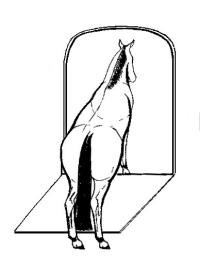|
By A. & M. McLean, The Australian Equine Behaviour Centre,
Clonbinane Road, Clonbinane Victoria 3658
Australia.
Phone (03) 5787 1374 Fax: (03) 5787 1220 e-mail eqbehsol@ontherun.com.auAbout the Authors:
Andrew and Manuela McLean are acknowledged experts on the subject of horse training
and understanding equine behaviour. Training the horse to load easily on a float is
usually a procedure that presents no problems if approached correctly. These notes
are intended to give guidance and a step by step method that will work in most cases.
If the horse has already demonstrated difficulties in this part of the education
process, or has had a bad experience, you may need to discuss your individual problems
with Andrew and Manuela. The e-mail address is included.
Before you begin to try and load a horse on a
float, be sure that you know what you are doing. Seek the assistance of an
experienced person as you may begin bad habits that take a very long time to cure.
FLOATING
 Aim: The
horse learns to step forward or backwards calmly into and out of a horse float. Aim: The
horse learns to step forward or backwards calmly into and out of a horse float.
You should be able to halt the horse at any
point on the way in or out using the reins, and later the lead rope. You should be
able to move the horse forward when trained using any of the following:
- the reins
- the lead rope; or
- the whip;
After halting at any point on the tailgate or
inside the float. The horse should be completely calm, straight and obedient at all
times. The horse should not feel enough stress to begin sweating.'
Action: The
horse should walk calmly on or off a horse float in response to the forward and backward
action of the reins on the bit, and to a tap from the dressage whip.
Important: In
this exercise, after the horse gives a clear response, be completely silent, except to say
"good boy". You may also combine the words with a soft scratch at the base
of the mane, as a reward.
Note: Before
beginning this exercise your horse should be well trained in the 'Stop and Go' exercises
in my leaflet Gaining Calmness and Clear Responses in Hand.
Step-by-Step
- Floating should initially be trained with a
bit in the horse's mouth, so it is possible to give cues for clear backwards steps, and
precise halts.
- Prepare the float by removing any dangerous
projections, ensuring that the floor is dry. Open the central partition to maximum width
and secure it.
- Stand on the nearside between the horse's head
and shoulder, facing its rump so that you can notice and attend to the horse's
incorrect responses (you will face the same way as the horse only when his responses
become correct ones.)
- Your left hand, which is holding the reins,
should be about 20 cm from the horse's chin - just below and behind it. Have a
dressage whip in your right hand with your index finger pointing to the whip tip.
- For this exercise - forward movement - you
should tap on the floppy muscle above the elbow (because it is always in reach) and not on
the horse's ribcage, even if he rushes backwards.
- Your whip will be used to provide relative
discomfort when the horse does not lead from the light forward-leading pressure
of the reins. So every time you tap the horse, you must precede and overlap the
tapping with this mild head pressure, because you are training him to eventually respond
to the suggestion of the reins (and later the lead rope) as the only cue. The
head pressure therefore is the mild motivator, the whip-tap is the strong motivator, and stopping
both as soon as the horse responds correctly is the primary reward. So when the
horse steps forward, soften the lead and cease tapping instantly.
- If the horse runs forwards, or panics at the
new cue, stop him immediately with the reins.
- The horse should move forward and backwards
calmly before you begin to load him. When the horse gives calm, clear, and precise
responses to 'Stop" and 'Go', he is ready to approach the horse float.
- The handler should aim to keep the horse
facing the interior of the float at all times. Under no circumstances is the horse
allowed to turn away and be re-presented.
- If the horse looks away to the left,
straighten his head by vibrating the right rein, and vice versa. Be strict about having
the horse face forward, as looking away is a precursor to turning away.
To move the horse towards the
float, lead up and tap the horse as described above. Continue tapping if the horse
moves sideways (because it is not forward movement and not correct).
Reminder: Whenever the
horse steps forward, the mild lead pressure and the tapping MUST cease immediately.
If the horse runs backwards
you must run with him, and continue tapping until he steps forward, no matter how far
he runs. Tap more intensely the more he resists forward, and the faster he runs
backwards.
If the horse rears and spins
away, do not stop tapping (otherwise you will train him to rear). Continue tapping
until he steps forward, then instantly soften the rein and cease tapping.
As before, if the horse runs
forward, he must be stopped from running immediately with the reins.
If the horse goes onto the
float and then begins to run out, begin tapping and maintain mild head pressure
immediately he begins to run backwards. Soften and cease when he steps forward.
If the horse turns his head
and neck at any point in the float, he must be straightened instantly by
vibrating the reins in the opposite direction.
- Continue the system of 'Stop' and 'Go' until the horse is in
the float.
- At any point, you will know the training is successful when
you can load the horse half way, change your mind, and back him off the float again.
Practise taking the horse four steps on, two steps off, three steps back on, and so
on.
Refine
- You have trained the initial stages of loading
successfully when the horse will take controlled steps at all times forward or
backwards, on and off the float.
- Now you are ready to turn around and face the
same direction as the horse, holding the reins in your right hand and the whip in your
left hand, across your right hip. pointing to the horse's ribs.
When the horse is loading
successfully and calmly with no mistakes, and you can stop and go wherever you
wish, you are ready to half close the float's central partition so that the horse has only
the normal space to walk through.
When the horse loads into this
new space calmly and successfully, you can begin 'casting' the horse into the float.
That is, you do not quite go all the way into the float, instead sending him a
little past you. To 'shape' this training, you take less and less steps into the
float, moving the horse farther past you each time.
At this stage, if he slows,
you can give him a mild tap with the whip to continue moving him into the front of the
float.
You must not proceed
to any of these levels until you have achieved the previous ones with absolute calmness
and obedience. If you do, you may risk a dangerous situation - always stand clear of
the horse's back legs.
Finally, you are ready to load
the horse in an ordinary headcollar.

Jeep, Hayman Reese & JR Easy Traveller
- the
perfect towing combination.
|


 Aim: The
horse learns to step forward or backwards calmly into and out of a horse float.
Aim: The
horse learns to step forward or backwards calmly into and out of a horse float.